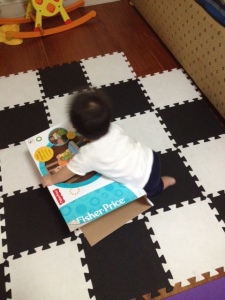“A child who does not play is not a child, but the man who does not play has lost forever the child who lived in him.”
-Pablo Neruda, 1904-1973
This is the last for the Babies and Play Series. I can’t end this series without having to discuss why our roles, as parents, matter in our child’s development. So fellow parents, I hope you take time to read through this, and share this to your fellow parents as well so we can reflect on how we can support our child/children even more. 🙂
Studies will tell you that the first three years of a child’s life is the most crucial stage in his entire life. There are several factors that influence your child- the kind of environment he grows up with (home, school, community), the types of people he interacts with day in and day out (both immediate family, peers, other people), and more importantly, the values that you teach him early on (your family values, your goals for him, etc.).
A report from the American Academy of Pediatrics (AAP) emphasised that the most valuable and useful character traits that will prepare your children for success in life come not from academics or extracurricular activities but from “a firm, grounding in parental love, role modelling and guidance.”
Today, I will focus on discussing how your role as parents can greatly affect your child’s play. As your child’s primary caregiver, you need to be aware that your influence begins even before your child is born. From prenatal care until your child is able and independent, you are very much needed. It’s a 24/7 commitment, which I only fully understood when I became a parent myself. ( and I know that there’s still so many more to realise later on as Ellie grows up…)
Despite the sleepless nights and challenging times such as running after your toddler, dealing with tantrums, handling accidents and many more, parents will agree with me when I say that there’s this unexplainable satisfaction and joy of seeing your child grow up healthy, safe, and happy. 🙂
As we have discussed in the previous series, play is the primary vehicle in which our babies learn.As parents, you might ask, what can I do to help my baby play? There are so many things that you can do to help your baby play, and it won’t even take much of your time. No matter if you are working or a full-time parent, here are some tips I have gathered which you can easily do at home and teach to your child’s caregiver or other family members who care for your baby.
Here are some tips taken from the article, Helping Babies Play by Sawyers and Rogers (2003) together with some input from my own experiences:
Birth to 4 months: (At this stage, babies explore the world with their eyes. To help them with exploration:)
* Talk to babies in a playful way. Smile and repeat sounds-again, and again! Stop between sounds and watch for them to smile or move in response to your voice. If you get a playful response, repeat it.
* Sing to the baby. Make up songs just for this baby. Dance with the baby nestled on your shoulder.
(What I normally do is I keep a collection of songs that I let Ellie listen to. Have a variety of songs from lullaby songs, to action songs and rhyming songs. I also put a variety of both slow and fast songs. I also make sure that she listens to both English and Filipino songs. You can research online (youtube) or you can visit the local record bar (local department store or at the mall) for available cds/music for babies.
*Play with the baby’s hands and feet, gently patting and rubbing, saying silly soft sounds to match. “Pedal the baby’s legs for a bike ride, describing where you’re going.
4 to 8 months: (at this stage, infants use not just eyes, and ears but hands and mouth to explore objects)
*singing special songs while changing diapers and clothes or cutting nails
*engaging them with finger plays such as “The Little Piggy Went to Market” and other finger play/nursery rhymes with their toes
(I remember telling The Five Silly Monkeys finger play to Ellie as early as her first month. It was amazing that she will stop whatever she is doing and just listen to the tone of my voice. Until now (She’s almost turning 1), she does the same thing whenever I start saying this finger play.
8 to 12 months: (At this stage, babies are fully active in exploring their world. Many crawl or creep, some walk holding on while some are independently walking. They combine objects and practice dropping, throwing and squeezing)
*Help babies practice sounds by repeating their sounds back- for example, dada, oh, oh, and by the end of the first year, words like kitty, baby, and doll. Don’t limit speech to imitating babies but extend and expand their words into sentences
* Read to the baby.
(Reading is a big part of Ellie’s routine. There are a variety of books available at home, mostly board books with various topics from animals, to body parts, to babies. I also put a mixture of English and Filipino books (adarna books are the best) for her to explore. I also make sure that there’s a book in the areas that she frequents at home, whether during meal times, beside her crib, in her baby bag. I believe that when you have books at hand already, it refrains you from choosing easier alternatives (using your phone or tablet) to calm your child or to get her attention.)
*Provide toys that challenge the infant’s skills. Children this age practice pulling, pushing, poking, punching
* Introduce toys with more than one part. Infants this age especially like things that fit inside something else.
*Stretch baby’s arms above her head asking, “How big is baby? Sooo Big!” After awhile, baby will hold her arms up alone to respond to your question
*Play Pat-a-Cake, Peek-a-Boo with the baby.
*Children in this age group enjoy the sensory feeling of moving through space- riding piggyback, swinging in child-seat swings, riding in wagons, and dancing in an adult’s arms. Older babies also enjoying bonding on an adult’s knees to the accompaniment of a song or a verse.
12 to 18 months (At this stage, infants are great experimenters. They try out all their skills this way and that just to see what will happen. The first pretend play occurs in this group when infants begin to act “as if” doing daily activities. They pretend to sleep, eat, or bathe. They then apply these acts to others and later copy others’ behaviours as their own)
*Provide simple pictures of familiar items (laminated cover with clear plastic, or put into zip-type plastic bags) for baby to practice naming
*Read to the baby, talking about the book as you go
*Provide safe places (indoors and outdoors for moving-walking and climbing. Tunnels and cabinets provide opportunities for going in, out, through and under. Think about safety always
*Be the receiver of the child’s pretend actions. Take a drink from the empty cup, smack your lips, and say, “Ummm, good”. Let the child comb your hair or pretend to wash your face. Then extend the pre tense to another recipient such as the cool. Support the child’s language development by narrating the drama as it progresses, “Jimmy is asleep”. or “I’m getting a bath”
*Provide real-looking toys for daily activities such as eating, bathing, riding and cleaning. Important toys for pre tense at this age are: dolls (representative of racial/ethnic groups); daddy, mommy, brother, sister; transportation vehicles: boats, planes, cars, trains
One of my favorite bonding times with Ellie is when we play together. I love seeing her marvel at simple toys, a ball or a block that she can explore for long periods of time. I enjoy running after her, and listening to her babble while she points to the different things she sees in her play room. I like reading to her in that small corner of our room, where she tries to flip the pages of her book and laugh at the sight of pictures that she sees. 🙂
Playing with Ellie has reminded me that I can still be a child every now and then, and how playing can be a source of both fun and learning. 😉
References:
Sawyers, J. k. & Rogers, C.S. (2003). Helping Babies Play. Young Children on the Web. pp.1-2





Comments are closed here.